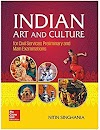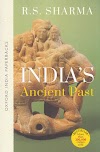Mauryan Architecture
In the rear part of the Vedic Period, the progressive section of the society started Sramana Movement (Sramana - one who strives for his own enlightenment).
It was an anti-vedic movement which was against the discriminatory practices of Vedic Period like sub-ordination of women and shudras, Brahmanical domination, complex vedic rituals, animal sacrifices, etc.
Later Buddha and Mahavira emerged as the tallest leader of Sramana Movement. Sramana Movement also gave rise to Ajivikas.
When Mauryas came to power, they too started to patronise Sramana tradition. They created many structures for the branches of Sramanas.
Architecture of Mauryas -
- Cave Architecture
- Stupa Architecture
- Sculpture Architecture
- Pillars
- Pottery
1. Mauryan Caves (Rock-cut Cave Architecture)
- They were considered as the first man-made caves in India.
- The Mauryan Caves were highly polished from inside and a very beautiful semi-circular façade shaped was created on the entrance.
- Most of the caves were created by Ashoka and his grandson Dashrath.
- These caves were created for Ajivika Monks.
- Example - Lomas Rishi Cave, Sudama Cave (Barabar and Nagarjuni hills, Bihar), Dhauli Cave of Odishi, etc.
- In front of Dhauli Cave, a large elephant structure was created by Mauryans.
2. Mauryan Pillars
When the Mauryas were ruling in India, Achmanians were ruling in Persia. Both the dynasties were known for making pillars.
Difference between Mauryan Pillars and Achmaninas Pillars
Mauryan Pillars
- It was monolithic, i.e., made from a single stone.
- They were installed in open.
- Average height of Mauryan pillar is 40 ft.
- Mauryan pillars were highly polished.
Achmanians Pillars
- They were made in pieces and later joined together.
- They were installed inside the building.
- Average height of Achmanians pillars is 15 ft.
- They were also highly polished.
Purpose of Mauryan Pillars before Kalinga war
- It was erected for celebrating the victory.
- Mauryan pillars were used for serving imperial sermons, orders or commands.
Purpose of Mauryan Pillars after Kalinga war
- It was meant for spreading the message of Dhamma (doctrine of Buddhism).
- They were meant to celebrate the important life events of Buddha.
Mauryan pillars mainly consist of 4 parts -
- Shaft - A long shaft formed the base, which is monolithic, i.e., it is made up of a single piece of stone.
- Capital - On top of the Shaft lay the capital, which is either lotus shaped, or bell shaped.
- Abacus - Above Capital, there is a circular or rectangular base which is known as abacus upon which the capital figure was installed.
- Capital figure (Crowning Animal) - Figures of some animals like lion, bull, elephant, etc was installed on the Abacus.
 |
| Sarnath Pillar |
 |
| Bull Capital, Rampurva |
Note - Abacus + Crowning animal of Sarnath pillar is the State Emblem of India and the emblem text "Satyameva Jayate" is taken from Mundaka Upanishad.
The Saranath Pillar indicates Dharmachakra Parivartan (i.e., turing the wheel of law and religion).
3. Stupas
- Stupa is a Sanskrit word which means 'heap of sand'.
- The concept of Stupa originates in Vedic Period and it was carried forwarded by the followers of Buddha.
- When Ashoka accepted Buddhism, then he decided to create 9 large Stupas on the relics/remains of Buddha.
- Alakappa
- Ramagrama
- Vethapida
- Pippalvina
- Rajgriha
- Kushinagar
- Vaishali
- Pava
- Kapilvastu
- Sanchi Stupa - Which is one of the biggest Stupa does not have the relics of Buddha.
- The art of Stupa building reached its climax during the time period of Ashoka and nearly 84,000 Stupas were build during his time period.
- Stupas were half dome shaped (hemispherical) structure which is known as Anda surrounded by wooden fencing (Vedica) and Toranas where Jataka Stories were written. Later wooden fencing was replaced by Stone fencing.
- A Stupa generally consists of -
- Anda - It is the hemispherical mound.
- Medhi - Relics of Buddha was placed in Medhi.
- Chatras - The three discs/umbrellas of chatras at the top of the Stupa represents the three gems of Buddhism, i.e., Buddha (the awakened one), Dhamma (the doctrine of Buddhism) and Sangha (the order of Buddhism).
- Yatri - It represents the axis in which the Chatras was attached.
- Harmika - It was the central pillar which supports the triple umbrella form (Yatri and Chatras).
- Pradakshina Path - It was a pathway meant for devotees to walk around the Stupa.
- Vedica - It was the boundary wall up on which Jataka Kathas were written. Earlier Vedicas were made up of woods but later stones were sued to make vedicas. (Jatak Stories are the stories which are related to the previous life of Buddha (Bodhisattva). They are mythological in nature but at the same point of time they are didactic (i.e., they give moral intellectual lessons) in nature.
- Toranas - It is the gateway of the Stupa. There were 4 Toranas in a Stupa depicting 4 important life events of Buddha which are Birth (represented by East Torana), Enlightenment (represented by South Torana), Dharmachakra Parivartana (represented by West Torana) and Mahapari Nirvana (represented by North Torana).
- Overall, the Stupa is considered as the body of the Buddha, i.e., Symbolically Stupa is a microcosm (small representation) of Buddha (Hermika+Yatri+Chatras represent the head of Buddha, Anda represents body of Buddha and Medhi represents the led of Buddha).
- Material used in the construction of Stupa - The core of the Stupa was made of unburnt brick while the outer surface was made by using burnt bricks which were then covered with thick plaster.
- Example - Sanchi Stupa (MP), Piprahwa Stupa (UP), etc
4. Mauryan Sculpture
- Mauryan rulers created sculptures of Yaksha and Yakshini. Yaksha and Yakshini were objects of folk worship in all over India.
- In Jainism, there was a concept of 29 Yakshini who were worshipped.
- In Buddhism, images of Yakshini were created on the gateways of Stupas. The most popular Yakshini in Buddhism is Salbhanjika Yakshini. It depicts Yakshini holding branches of a Sal tree. She is considered as very auspicious in Buddhism.
- Yaksha worship is mentioned in Mahabharata. Yakshini in Hinduism was worshipped in Saptamatrika puja.
- Tamil epic Silapadhikaram also mentioned about worship of Yakshini in South India.
5. Mauryan Pottery
- The characteristics pottery of Mauryans were Northern Black Polished Ware (NBPW) pottery.
- It was the climax of pottery making.
- They used very fine particles of clay and pottery was created on a very fast moving wheel which resulted into even shaped smooth pottery which was coloured in black and was highly polished.
Previous Article - Harappan Architecture
Next Article - Post Mauryan Architecture
Notes on other subjects
Optional Notes
Note - This is my Vision IAS Notes (Vision IAS Class Notes) and Ashutosh Pandey Sir's Public Administration Class notes. I've also added some of the information on my own.
Hope! It will help you to achieve your dream of getting selected in Civil Services Examination 👍











0 Comments